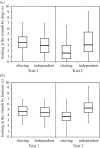Perception of animacy in dogs and humans
- PMID: 28659418
- PMCID: PMC5493738
- DOI: 10.1098/rsbl.2017.0156
Perception of animacy in dogs and humans
Abstract
Humans have a tendency to perceive inanimate objects as animate based on simple motion cues. Although animacy is considered as a complex cognitive property, this recognition seems to be spontaneous. Researchers have found that young human infants discriminate between dependent and independent movement patterns. However, quick visual perception of animate entities may be crucial to non-human species as well. Based on general mammalian homology, dogs may possess similar skills to humans. Here, we investigated whether dogs and humans discriminate similarly between dependent and independent motion patterns performed by geometric shapes. We projected a side-by-side video display of the two patterns and measured looking times towards each side, in two trials. We found that in Trial 1, both dogs and humans were equally interested in the two patterns, but in Trial 2 of both species, looking times towards the dependent pattern decreased, whereas they increased towards the independent pattern. We argue that dogs and humans spontaneously recognized the specific pattern and habituated to it rapidly, but continued to show interest in the 'puzzling' pattern. This suggests that both species tend to recognize inanimate agents as animate relying solely on their motions.
Keywords: chasing; comparative perception; perceptual animacy; social perception.
© 2017 The Author(s).
Conflict of interest statement
We declare we have no competing interests.
Figures
References
MeSH terms
Associated data
LinkOut - more resources
Full Text Sources
Other Literature Sources

